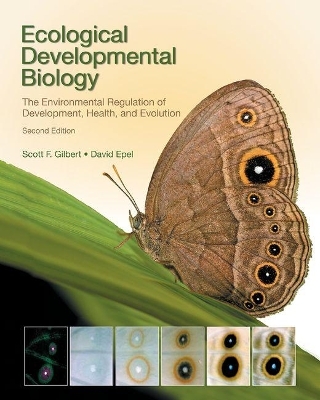
Ecological Developmental Biology
Oxford University Press Inc (Verlag)
978-1-60535-344-9 (ISBN)
The new evolutionary science created by this approach to nature is called ecological evolutionary developmental biology (eco-evo-devo). The book documents the evidence for a new, extended, evolutionary synthesis, a synthesis that: confounds the creationist belief that evolution can't be described above the species-level; integrates aging and 'Western' diseases such as diabetes, atherosclerosis, cancer, and obesity into an evolutionary context; and sees interspecies interactions both within the organism and between organisms as being critical for evolution, development, and fitness.
The only book that, in one place:
Details the three main epigenetic sources of phenotype: symbionts, altered chromatin structure, and plasticity.
Discusses the various ways that development can be disrupted: teratogens, endocrine disruptors, global climate change, and mismatches between diet and environment.
Documents the evidence for an extended evolutionary synthesis involving the modern synthesis, evo-devo, and eco-evo-devo.
Scott F. Gilbert, Swarthmore College and the University of Helsinki, and David Epel, Emeritus, Stanford University, USA. Scott F. Gilbert, a Senior Research Associate at Swarthmore College and the Finland Distinguished Professor at the University of Helsinki Institute of Biotechnology, teaches developmental biology, developmental genetics, and the history of biology. After receiving his B.A. from Wesleyan University, he pursued his graduate and postdoctoral research at The Johns Hopkins University and the University of Wisconsin. Dr. Gilbert is the recipient of several awards, including the first Viktor Hamburger Award for excellence in developmental biology education, the 2004 Alexander Kowalevsky Prize for evolutionary developmental biology, honorary degrees from the Universities of Helsinki and Tartu, and the Medal of François I from the Collège de France. He is a Fellow of the American Association for the Advancement of Science, a corresponding member of the St. Petersburg Society of Naturalists, and has been chair of the Professional Development and Education Committee of the Society for Developmental Biology. His research pursues the developmental genetic mechanisms by which the turtle forms its shell. David Epel is the Jane and Marshall Steel Jr. Professor Emeritus of Biological Sciences at Stanford University`s Hopkins Marine Station in Pacific Grove CA. He did his undergraduate studies at Wayne State University and then graduate and postdoctoral studies at the University of California, Berkeley and the University of Pennsylvania. Dr. Epel has been a Guggenheim Fellow, is a Fellow of the American Association for the Advancement of Science, the California Academy of Sciences, and an Overseas Fellow of Churchill College and Life Fellow of Clare Hall at the University of Cambridge. His honors include the Cox Medal for Fostering Undergraduate Research at Stanford and the Ed Ricketts Memorial Award for Lifetime Achievement in the Marine Sciences. Epel`s research focused on cell biology of development, especially the activation of the egg at fertilization, the unique physiology of the embryo and the cellular mechanisms of embryo protection. His current interest is high school science education. One area is highlighting early development of the sea urchin embryo to capture the imagination and interest of high school students. New curricula focus on the science of climate change and how students can help to solve this problem.
PART I: ENVIRONMENTAL MODES OF NORMAL DEVELOPMENT .- 1. Plasticity: The Environment as a Normal Agent in Producing Phenotypes.- 1.1. Honeybee Queen Determination.- 1.2. Mechanisms of Fish and Turtle Sex Determination.- 2. Environmental Epigenetics: How Agents in the Environment Effect Molecular Changes in Development.- 2.1. Mechanisms of DNA Methylation and Epimutation l Inheritance of Non-coding RNAs.- 2.2. Alteration of Chromatin State by Metabolism.- 2.3. Toxoplasma-induced Changes in Host Behavior Through DNA Methylation.- 2.4. Environment-induced Gene Expression of Hormones Through Invertebrate and Vertebrate Life Cycles.- 2.5. Environmentally induced Changes in Genes Involved in Behaviors.- 2.6. Alteration of Chromatin State by Exercise.- 2.7. Mechanisms of Transgenerational Inheritance of Epialleles.- 3. Developmental Symbiosis: Co-Development as a Strategy for Life.- 3.1. Tidal Seagrass Symbioses.- 3.2. Global Climate Change and Symbioses.- 3.3. Acoustic Signaling of Larval Development.- 3.4. Holobiont Perspective on Developmental Individuality.- 3.5. Symbionts Critical for Early Development.- 3.6. Symbionts in Salamander Development.- 3.7. Mechanisms of Developmental Symbiosis in Euprymna Squids.- 3.8. Symbionts as Determinants of Reproductive Isolation and Speciation.- 3.9. Symbionts and the Evolution of Social Insects.- 3.10. Birth as Continuation of Symbiotic Associations.- 3.11. Alteration of Immune and Brain Development by Gut Bacteria.- 3.12. Symbionts and the Development of Behaviors.- 3.13. Symbionts and the Induction of Transcription Factors.- 3.14. Co-metabolism: Symbionts and Bone Disease and Kwashiokor.- 3.15. New Data on the Hygiene Hypothesis.- PART II: ECOLOGICAL DEVELOPMENTAL BIOLOGY AND DISEASE STATES.- 4. Developmental Physiology for Survival in Changing Environments.- 4.1. Mutational Robustness.- 4.2. Parental Protection.- 4.3. Redox Protection and Signaling.- 4.4. Maternal Protection Against Pathogens.- 4.5. Innate/Chemical Immunological Defense.- 4.6. Symbiosis and Pathogen Defenses.- 4.7. Larval Defenses.- 4.8. Climate Change: Temperature.- 4.9. Climage Change: Ocean Acidification.- 5. Teratogenesis: Environmental Assaults on Development.- 5.1. Mechanisms of Thalidomide Pathology.- 5.2. Heavy Metals and Fish Development.- 5.3. Neurons and Neural Tract Development and Fetal Alcohol Syndrome.- 5.4. Mechanisms of Retinoic Acid Teratogenesis.- 5.5. Glyphosate Pesticide Teratogenicity.- 5.6. Teratogens and Behavioral Conditions.- 5.7. Systems Biology and Teratogenesis.- 5.8. Teratogenesis from Oil Spills.- 6. Endocrine Disruptors.- 6.1. New Estrogen Receptors and EDC Binding Patterns.- 6.2. Phytoestrogens and Hormonal Disruption.- 6.3. Phthalates and Genital Morphology.- 6.4. Mechanisms of Obesogen Action in EDCs.- 6.5. Bisphenol-A in Human Infertility and Cancer.- 6.6. Bisphenol-A, the Nervous System and Behavior.- 6.7. Transcriptome Analyses of BPA Targets.- 6.8. Tricosan and Thyroid Inhibition.- 6.9. Fracking and Endocrine Disruptive Compounds.- 6.10. Transgenerational Effects of Endocrine Disruptors.- 7. The Developmental Origin of Adult Diseases.- 7.1. Developmental Stress Hormones and Adult Disease.- 7.2. Gene Expression Differences Caused by Intrauterine Diets.- 7.3. Paternal Epigenetic Effects.- 7.4. Gene Differences in Vitro Fertilization.- 8. Developmental Models of Cancer and Aging.- 8.1. Integration of Insulin-dependent, TOR Aging Pathways.- 8.2. The Epigenetic Aging Clock.- 8.3. Aging, Senescent Cells, and the Origins of Cancer.- 8.4. Paracrine and Field Hypotheses of Cancer.- 8.5. Criticality of the Stroma to Epithelial Cancers.- 8.6. Context-dependent Cancer Cells and Paracrine Environments.- 8.7. Cancer and Epimutations.- PART III: TOWARD A DEVELOPMENTAL EVOLUTIONARY SYNTHESIS .- 9. The Modern Synthesis: Natural Selection of Allelic Variation.- 9.1. Global Climate Change and Selection.- 9.2. Development and Sexual Selection.- 9.3. Developmental Mechanisms of Rapid Speciation.- 10. Evolution through Developmental Regulatory Genes.- 10.1. Regulatory Genes in Microevolutionary Change: Hair Colors.- 10.2. Regulatory Gene Changes in Batesian and Mullerian Mimicry.- 10.3. Snake Rib Development.- 10.4. Genes Regulating Human Brain Growth.- 10.5. Heterochronic Derivation of Dinosaur and Bird Skulls.- 11. Environment, Development, and Evolution: Toward a New Synthesis.- 11.1. Holobiont as Possible Unit of Evolutionary Selection.- 11.2. Holobiont Selection in Pea Aphids.- 11.3. Alteration of Host Genome by Symbionts.- 11.4. Reproductive Isolation Caused by Symbionts.- 11.5. Symbionts and the Origins of Multicellularity.- 11.6. Epiallelic Inheritance in Vertebrates and Invertebrates.- 11.7. Paramutants and Parent of Origin Effects.- 11.8. Plasticity-driven Evolution in Limb Evolution.- 11.9. The Domestication Syndrome in Mammals.- 11.10. Cryptic Genetic Variation and its Importance in Evolution.- 12. Coda: Philosophical Concerns Raised by Ecological Developmental Biology.- 12.1. Implications of Ecological Developmental Biology `Individuality`.- 12.2. `Becoming with` and `Being Against` Strategies of Evolution.- 12.3. New Metaphors of Evolution and Development.- 12.4. New Ways of Teaching Evolution, Development, and Ecology.- 12.5. Re-introducing `Natural History` into the Curriculum.- 12.6. Anthropocene as Event Not Epoch.- 12.7. Monarch Butterfly and Honey Bee as Critical Cases for Eco-devo.- 12.8. Environmental Justice and Development.- 12.9. `Terroir`.- Appendix A: Lysenko, Kammerer, and the Truncated Tradition of Ecological Developmental Biology.- Appendix B: The Molecular Mechanisms of Epigenetic Change.- Appendix C: Writing Development Out of the Modern Synthesis.- Appendix D: Epigenetic Inheritance Systems: The Inheritance of Environmentally Induced Traits.
| Erscheinungsdatum | 10.02.2016 |
|---|---|
| Zusatzinfo | 576 p. |
| Verlagsort | New York |
| Sprache | englisch |
| Maße | 190 x 235 mm |
| Themenwelt | Naturwissenschaften ► Biologie ► Allgemeines / Lexika |
| Naturwissenschaften ► Biologie ► Evolution | |
| Naturwissenschaften ► Biologie ► Genetik / Molekularbiologie | |
| Naturwissenschaften ► Biologie ► Ökologie / Naturschutz | |
| Schlagworte | Biology • Climate • climate change • Development • Developmental Biology • Ecology • Embryo • Embryology • Entwicklung (Biologie) • Environment • Evolution • Invertebrate • mammals • nervous system • symbiosis • Vertebrate |
| ISBN-10 | 1-60535-344-2 / 1605353442 |
| ISBN-13 | 978-1-60535-344-9 / 9781605353449 |
| Zustand | Neuware |
| Informationen gemäß Produktsicherheitsverordnung (GPSR) | |
| Haben Sie eine Frage zum Produkt? |
aus dem Bereich


